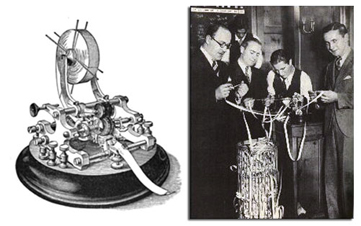Financial Innovations
Financial innovation has had a profound impact on how Americans manage their money.


Financial innovation has had a profound impact on how Americans manage their money. The proof is in the simple fact that many of the innovations that emerged during the last century remain indispensable to our financial well-being today.
Don’t believe it? Take a look at our list of 15 of the greatest innovations of the 20th Century.
See if you agree, or share your own greatest financial innovations in the reader comment box below or on Kiplinger’s Facebook page.

1935: Creation of Social Security
President Franklin Delano Roosevelt signs into law the Social Security Act, which is designed to provide income to retired workers in old age. Over the years, the program expands to cover dependents, survivors and the disabled. In 1940, Ida May Fuller is the first recipient of a monthly benefits check. The amount: $22.54 (about $362 in today’s dollars). Today, 54 million Americans receive Social Security benefits, with an average payout of $1,064 per month as of the end of 2009.

1994: Amazon.com
Jeff Bezos pioneers Internet commerce with an online bookstore where people can search for books throughout the world and place orders directly. Amazon.com immediately becomes a formidable competitor to brick-and-mortar bookstores and later expands to selling CDs, DVDs, computers, clothing, furniture, food, toys and more. Forrester Research says online retail sales will reach $192 billion this year, 7% of total retail sales, and reach 8% by 2014.
Further enhancements include one-click shopping, customer reviews and e-mail order verification. Amazon.com’s annual sales hit $34.2 billion in 2010; online sales for all e-commerce retailers total $145 billion (in 2009).

1974: Creation of the IRA
The Employee Retirement Income Security Act (ERISA) initiates new standards for retirement-plan sponsors and helps create the individual retirement account (IRA). Initially, workers not covered by an employer retirement plan can contribute up to $1,500 a year (and reduce taxable income by the same amount). Eligibility rules and contribution limits are loosened over the years.
A big perk: Savings grow tax-free until you start taking out the money. In 1997, the Roth IRA is introduced, which features non-deductible contributions and tax-exempt withdrawals.

1967: World’s First ATM
Barclays introduces the world’s first automatic teller machine (ATM) at a branch in London. Two years later, Chemical Bank in New York City debuts the first ATM in the U.S. Today, there are about 400,000 ATMs in the U.S.

1962: Walmart Is Born
Although five-and-dime stores date back to the 19th century, a watershed moment in discount retailing comes when Sam Walton opens his first Walmart store in Rogers, Ark. In the same year, Target and Kmart open their doors to bargain-hungry shoppers in Minnesota and Michigan, respectively. Walmart goes on to become the world’s largest retailer, with $419 billion in annual sales in 2010.

1933: Creation of FDIC
The Federal Deposit Insurance Corp. (FDIC) is created in response to the rash of bank failures before and during the Great Depression. The FDIC initially covers deposits up to $2,500 (about $43,000 in today’s dollars).
The current coverage limit is $250,000 per depositor, per insured bank. Since its founding, the independent government agency boasts that not a penny’s worth of insured deposits has been lost as a result of a bank failure. Today, the FDIC insures more than $7 trillion held in U.S. banks and thrifts.

1975: The Dawn of Discount Brokerages
Charles Schwab launches one of the first discount brokerage firms just a few months after the Securities and Exchange Commission tells Wall Street to stop fixing trading commissions, which often cost small investors $100 a trade. Investors can now trade stocks for less than $10. Today, Schwab’s clients alone have 8.1 million brokerage accounts.

1946: First Bank Credit Card
John Biggins, a banker at Flatbush National Bank in Brooklyn, N.Y., creates the first bank credit card, known as “Charg-It.” Four years later, Diners Club becomes the first charge card in widespread use, with 20,000 cardholders by 1951. U.S. consumers now have about 610 million credit cards, with the average cardholder carrying 3.5 cards.

1913: Assembly Line
Henry Ford incorporates the first moving assembly line for large-scale manufacturing into the mass production of his Model T car. As a result, the Model T costs less to build than other vehicles.
It eventually sells for as little as $260 (about $5,900 in today’s dollars), down from an original price tag of $850 ($19,300 today), thanks to savings realized from Ford’s assembly-line concept. The manufacturing revolution makes countless products more affordable to the consumer.

1981: First Frequent-Flier Program
American Airlines introduces the world’s first frequent-flier program, AAdvantage Travel Awards, in which frequent travelers on American Airlines earn mileage credits for free flights and upgrades. United quickly launches a competing program, Mileage Plus, followed by Delta and TWA.
Twenty-five years later, there are 180 million members of frequent-flier programs worldwide. AAdvantage goes on to expand into non-airline businesses, although it isn’t the first loyalty-marketing program -- Sperry & Huchinson introduced the S&H Green Stamps at participating retailers in 1896.

1934: The Birth of Value Investing
Columbia University professors Benjamin Graham and David L. Dodd publish Security Analysis, forever change investing theory and practice, proposing new tenets that emphasize fundamentals and balance-sheet dissection over gut feelings and fads.
Decades later, Graham and Dodd’s “bible for value investors” continues to influence Wall Street. Warren Buffett, a Graham student and a prominent value-investing disciple, is currently worth $50 billion.

1978: Creation of the 401(k) Plan
Congress authorizes 401(k) defined-contribution plans in which employees can elect to have some of their pay put into a qualified retirement plan as a pretax reduction in salary.
The name is derived from the section of the Internal Revenue Code that authorizes the new retirement savings vehicle.
Hughes Aircraft, Johnson & Johnson and PepsiCo are some of the first companies to adopt the retirement plans. About 60 million workers in the U.S. now actively participate in 401(k)s.

1997: Billing and Payments Move Online
CheckFree introduces a program called “e-Bill” that allows for the viewing of utility, phone, and other bills on a single Web site.
Later in the same year, Microsoft and First Data create TransPoint, which allows consumers with Internet access and a secure Web browser to pay bills online. Banks soon follow.
In the U.S., 80% of all households with Internet access now use some form of online banking, and 40% of those wired households pay bills online.

1924: First Mutual Fund
Massachusetts Investors Trust launches America’s first “modern” mutual fund in which the average investor can own a diversified pool of stocks at an affordable price. Other features available to investors include diversification, professional management and liquidity. Mutual fund assets worldwide total $24.7 trillion by the end of 2010.

1976: First Index Fund
Newly formed Vanguard Group, with John Bogle at the helm, launches the Vanguard 500 Index, which tracks the performance of the 500 largest U.S. companies that make up the Standard & Poor’s 500-stock index. Bogle creates a simple-to-manage, low-cost fund for investors to gain diversified exposure to the U.S. equity market. Today, the index fund holds $112.6 billion in net assets.

More from Kiplinger
SLIDE SHOW: 20 Financial Innovations You Can’t Afford to Ignore
PRACTICAL ECONOMICS: The Future of Personal Finance
INNOVATOR PROFILE: Groupon's Andrew Mason
INNOVATOR PROFILE: Mint.com's Aaron Patzer
INNOVATOR PROFILE: Zipcar's Robin Chase
Get Kiplinger Today newsletter — free
Profit and prosper with the best of Kiplinger's advice on investing, taxes, retirement, personal finance and much more. Delivered daily. Enter your email in the box and click Sign Me Up.

-
 Social Security Is Taxable, But There Are Workarounds
Social Security Is Taxable, But There Are WorkaroundsIf you're strategic about your retirement account withdrawals, you can potentially minimize the taxes you'll pay on your Social Security benefits.
By Todd Talbot, CFP®, NSSA, CTS™
-
 Serious Medical Diagnosis? Four Financial Steps to Take
Serious Medical Diagnosis? Four Financial Steps to TakeA serious medical diagnosis calls for updates of your financial, health care and estate plans as well as open conversations with those who'll fulfill your wishes.
By Thomas C. West, CLU®, ChFC®, AIF®
-
 The Cheapest Places To Retire in the US
The Cheapest Places To Retire in the USWhen you're trying to balance a fixed income with an enjoyable retirement, cost of living is a crucial factor to consider.
By Stacy Rapacon
-
 Can Stocks Picked by Artificial Intelligence Beat the Market? 3 Stocks to Watch
Can Stocks Picked by Artificial Intelligence Beat the Market? 3 Stocks to Watchstocks An artificial intelligence stock-picking platform identifying high-potential equities has been sharp in the past. Here are three of its top stocks to watch over the next few months.
By Dan Burrows
-
 For a Concentrated Stock Position, Ask Your Adviser This
For a Concentrated Stock Position, Ask Your Adviser ThisThere can be advantages to having a lot of stock in one company, but ‘de-risking’ can help avoid some significant disadvantages.
By Robert Gorman
-
 Trusting Fintech: Four Critical Moves to Protect Yourself
Trusting Fintech: Four Critical Moves to Protect YourselfA few relatively easy steps can help you safeguard your money when using bank and budgeting apps and other financial technology.
By Shane W. Cummings, CFP®, AIF®
-
 Four Steps to Prepare Your Finances for Divorce
Four Steps to Prepare Your Finances for DivorceDivorce is rarely easy, but getting financial paperwork in order, working with professionals and making tough decisions now can take some of the stress out of it.
By Marcy Keckler, CFP®, CRPC®
-
 Stock Market Today: Nasdaq Gains as Treasury Yields Collapse
Stock Market Today: Nasdaq Gains as Treasury Yields CollapseThe tech-heavy index swung higher Monday as investors sought out safety in government bonds.
By Karee Venema
-
 Silicon Valley Bank, Signature Bank Failures Send Bank Stocks Reeling
Silicon Valley Bank, Signature Bank Failures Send Bank Stocks ReelingFinancial stocks continued to sell off following the collapse of regional lenders SVB and Signature Bank.
By Karee Venema
-
 5 Stocks to Sell or Avoid Now
5 Stocks to Sell or Avoid Nowstocks to sell In a difficult market like this, weak positions can get even weaker. Wall Street analysts believe these five stocks should be near the front of your sell list.
By Dan Burrows
